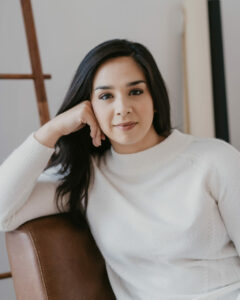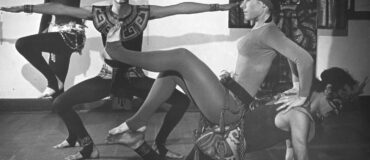By Amy Schofield
Amy Schofield is a 2024 Archiving and Preservation Fellow with the National Institute of Flamenco. Read more about the Fellowships here. This is the fourth part of Amy’s blog. Read the third part here.
An Illustrious Past, Far-Reaching Present, and Trail-Blazing Future
Now that my Fellowship period is coming to a close, I’ve been reflecting on the process as a whole and how archives of dance organizations differ from those of other fields. While other fields may deal mainly with paper and digital files, dance organizations commonly have a wide variety of material types: photographs, handbills from performances, choreographer’s notes, newspaper clippings, magazine articles, large-format posters, marketing postcards, VHS tapes, DVDs, Beta Max tapes, reel to reels, cassette tapes, vinyl records, CDs, 35mm slides, costumes, and more. Dance organizations also commonly have overlapping branches of programming where performers are also educators and/or choreographers. The speed with which these organizations flow from one performing season to the next often leaves little time for organizing documentation and ephemera from previous performances, leading to an ever-growing backlog of unprocessed archival material.
Additionally, company members, in a way, are the archive; the choreographies live in their bodies. Institutional knowledge and the various channels through which that knowledge is passed ebbs and flows with the comings and goings of company members and administration. While the National Institute of Flamenco’s embodied archive is alive and well in the bodies and minds of their dancers, teachers, and staff, their newly organized physical archive and library will contribute to the preservation of the history of flamenco in Albuquerque and the Encinias familial legacy.
The last few days of my Fellowship were spent making final decisions on how to physically organize what became fourteen boxes of paper ephemera, almost 300 books and bound music scores, processed and unprocessed VHS tapes, and archival backlog. I also made sure to create a space for incoming, unprocessed material from NIF’s current programming and performances. In addition, I’m putting the finishing touches on a manual that outlines best practices and describes the systems I created within the archive’s organization. This way, another archivist can come in and continue along the path that I carved out, maintaining a continuity that was nonexistent between myself and previous archivists.

Before and after images of the current archive room at the National Institute of Flamenco.
The current version of the library and archive at NIF is housed in a closet that was once an overflow space. Now, materials are much more organized and accessible. While there are still plenty of unprocessed materials, all of the paper ephemera has been processed and rehoused. The first column of shelving consists of digitized and inventoried VHS tapes and eight boxes from the Newspaper and Ephemera series. This column of shelves also contains a box of vinyl records and eight smaller boxes that contain older books that required greater preservation efforts. Lastly, one large and one small box of unprocessed photographs live in this column of shelves. To the right is NIF’s current book collection, which includes scholarly monographs, anthologies, dictionaries, music theory texts, and bound sheet music. To the right of that, it starts to get a little messy. The two right columns contain unprocessed material including DVDs, VHS tapes, cassette tapes, and two large plastic bins of 35mm. slides, Beta Max tapes, posters, and more. On the very top of the shelving space are a VCR, a digital camera, a printer/scanner, and a few boxes of archival supplies such as extra file folders. In the corner are rolls of large vinyl banners that NIF has used to advertise their performances, and a few photographs that were already framed hang on the far wall.

Dr. Nancy Lee Ruyter’s writing in one of her books that is now housed at NIF, complete with the location and approximate date she acquired it.
I spent a surprising amount of time organizing and inventorying the books in NIF’s library, which consists of recent and out of print books about flamenco and a wealth of other topics, including Mexican contemporary dance, Indigenous studies, Roma studies, Spanish history, Argentine tango, ballet, and more. Many of the books within NIF’s library previously belonged to Nancy Lee Ruyter, a Professor Emerita in the Department of Dance at the University of California, Irvine. While Dr. Ruyter’s research specialty is Balkan dance, she researched and practiced a variety of folk and concert dance styles. Her most recent book, La Meri and her Life in Dance Performing the World (2019), details the ways Russel Meriweather Hughes (La Meri) studied and performed various dance techniques from around the world, including flamenco. What fascinated me the most was Dr. Ruyter’s ritual of writing her name, the date she bought the book, and the city or conference where she bought it within the first few pages. Some books also contain Dr. Ruyter’s thoughts in the margins and underlined passages that held some meaning for her and/or her research.

A snapshot I took during the book inventorying process.
I asked NIF’s executive director, Marisol Encinias, how we came to possess so many of Dr. Ruyter’s books. Marisol told me that the books were originally donated to one of the libraries at UCI, along with Dr. Ruyter’s personal papers which are now housed (but unprocessed) in the Special Collections and Archives at University of California, Irvine. Because UCI already had many of these books in their library, they contacted the Fine Arts Library at the University of New Mexico. Fortunately for us, UNM’s Fine Arts Library also already had many of these books in some form, so they were then donated to NIF, who gladly acquired them. It’s fascinating to think of where these texts have been and to have these traces of Dr. Ruyter’s travels and research now in the NIF library in Albuquerque, New Mexico.
Looking broadly at my Fellowship work and my research, I’ve been thinking deeply about the importance of community in the creation of NIF’s archive and the various ways knowledge is stewarded and transmitted in community. Firstly, I could not have completed the work I did without the guidance of my mentor, Irlanda Jacinto. Her experience and expertise in dance archiving helped me to organize both the physical materials within NIF’s archive and my thoughts throughout the process. The oral history aspects of the project obviously could not have been completed without the participation of flamenco elders in the Albuquerque community. And, of course, the various materials within the archive would not exist without the company members and administrative staff that keep programming growing.
This project has been very special to me because I did my MFA at the University of New Mexico where Eva and Marisol Encinias were my professors. I lived in Albuquerque for three years, and I was welcomed by the flamenco community there, so it feels important to give back to the community in this way and work to preserve the legacy of the Encinias family and the role they have played in the development of flamenco in New Mexico.

Poster image for the 9th Biennial Flamenco History and Research Symposium .
Recently, NIF and I have been in conversation about how to make the archive more accessible to the wider community. As a first small step, we shared the process and what archiving the history flamenco in Albuquerque means with members of the Albuquerque community and an international group of flamenco scholars at the 9th Biennial New Perspectives in Flamenco History and Research Symposium, which took place October 2-4 on UNM’s campus. As part of a panel, Eva, Marisol, NIF’s Operations Director Annie D’Ozario, master guitarist John Truitt (whose oral history interview I discussed in my previous blog post), and I spoke about past NIF archiving efforts; recent progress with the help of the Dance/USA Fellowship; and dream futures for dance archiving, flamenco in Albuquerque, and its connections to time, place, and space. A recording of the panel presentation can be found here.
Next steps will hopefully include an exhibition of select archival material in upcoming flamenco festivals or in collaboration with other Albuquerque-based organizations. The work on this project is far from over, and I’m excited and proud to be a part of NIF’s illustrious past, far-reaching present, and trail-blazing future.
All photos courtesy of the author.
Header image: Eva Encinias with her company Ritmo Flamenco. Photo by Douglas Kent Hall.
All other photos courtesy of the author unless otherwise specified.

Amy Schofield (she/her) is a doctoral candidate in Dance Studies at The Ohio State University. She is a flamenco dancer, scholar, educator, and choreographer whose research explores the development and evolution of flamenco in the diaspora. Her dissertation analyzes the ways Latinx flamenco artists in the US can use their flamenco practice and performance as a decolonial praxis that mobilizes and reinterprets the percussive artform to reflect and serve Latinx communities. Amy holds an MFA in Dance from the University of New Mexico and a BFA in Dance from the University of the Arts (Philadelphia, PA). She has studied flamenco extensively in Spain and the US, and she regularly teaches and performs with U Will Dance Studio, The Flamenco Company of Columbus, and Caña Flamenca in Columbus, OH.
Photo credit: Elliot Archuleta
____
We accept submissions on topics relevant to the field: advocacy, artistic issues, arts policy, community building, development, employment, engagement, touring, and other topics that deal with the business of dance. We cannot publish criticism, single-company season announcements, and single-company or single artist profiles. Additionally, we welcome feedback on articles. If you have a topic that you would like to see addressed or feedback, please contact communications@danceusa.org.
Disclaimer: Opinions expressed in guest posts do not necessarily represent the viewpoints of Dance/USA.




